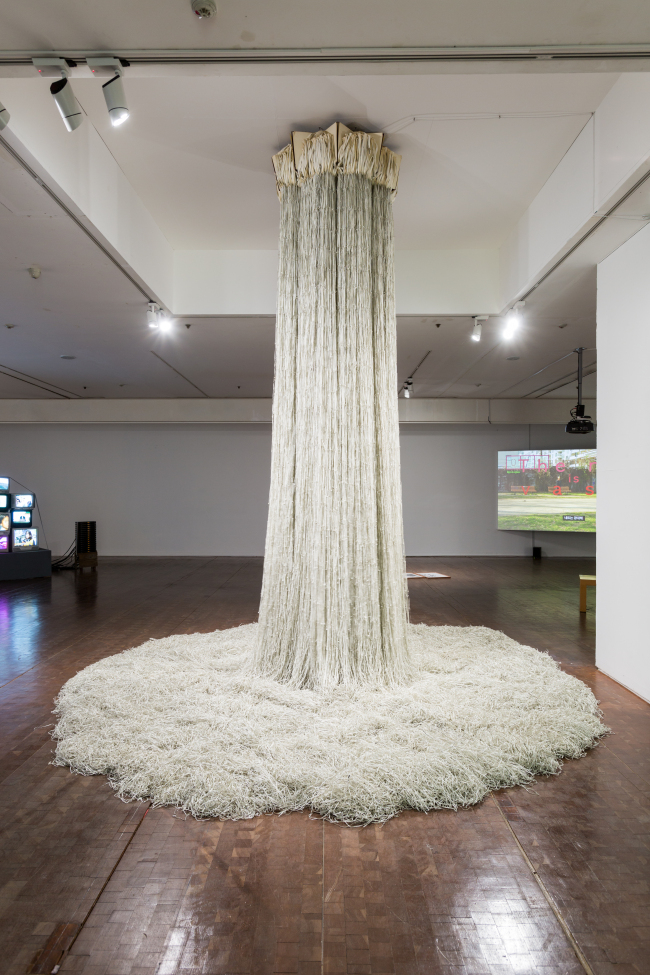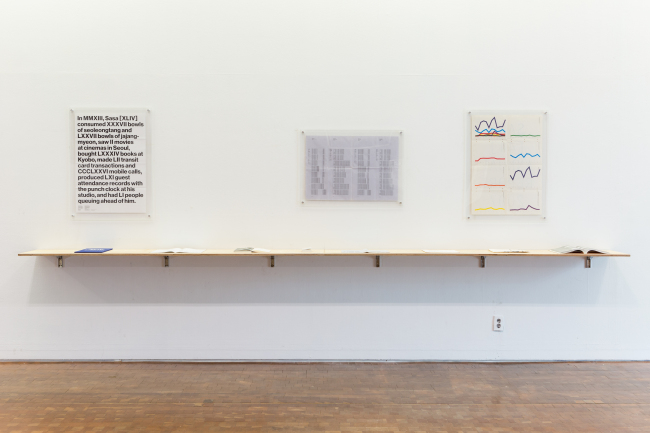With the click of a mouse, one can access a sea of information that was unimaginable before the advent of the World Wide Web.
But more often than not a flood of information causes frustration when one is searching for a single piece of information. In this era when one can access information instantly, choosing the right information can be a daunting challenge.
The confusion and irritation caused by what futurologist Alvin Toffler calls “information overload” in his 1970 bestselling book “Future Shock” is being examined in an exhibition underway at the Seoul Museum of Art.
In the show “Malfunction Library,” artists in their 30s and 40s present critical views of a deluge of information and also suggest alternative ways to produce and consume information. The event is part of an exhibition series showcasing works by young artists in the middle of their career.
 |
“fromthebooktothespace” by Kwon Juk-hee. (Seoul Museum of Art) |
Standing in front of Kwon Juk-hee’s installation of paper threads, viewers may feel as if they are lost in a dizzy stream of information. Kwon sliced every page of the Encyclopedia Britannica and glued the strips end to end into long-flowing threads. The paper threads dangle from the ceiling, looking like a waterfall in a valley. Entitled “fromthebooktothespace,” the work draws an analogy with the act of producing and consuming information nonstop.
Kim Kyoung-ho touches on two forms of information, original and edited. Having worked at the Korean bureau of Iranian Press TV, Kim displays two versions of news footage ― the original, which he filmed, and the scenes edited for broadcast. The two images are played on a single monitor to reveal slight changes between them and let viewers see how news events are interpreted. His work further prompts the audience to ponder whether it’s possible to discern correct information in today’s society of information overload, not to mention how an opinion can be shaped based on incomplete information.
Intangible information becomes visible in Kim Hwang’s “human library.” His artwork features interviews with activists and artists who share their thoughts on the role of art in speaking out about social issues. Viewers can access these pieces of real-life knowledge and experience by simply putting on headphones connected to a television set, instead of flipping through books. Information shown in his “human library” will become tangible on June 28 when all the interviewees gather for a discussion.
 |
“Annual Report” by Sasa. (Seoul Museum of Art) |
Artist Sasa has built his own library with a collection of personal records ― what he ate, how often he used public transportation, how many books he bought, how many movies he watched and so on.
“It’s his daily routine to keep records of his life,” said Park Ga-hee, curator of the exhibition.
The collected information is condensed into graphs expressing the traces of his life over a year. The year 2013 is summed up as follows: “In 2013, Sasa ate 37 bowls of the beef bone soup seolleongtang; 77 bowls of the Chinese noodles jajangmyeon; watched two movies at a theater in Seoul; bought 84 books at Kyobo Bookstore; made 52 transportation card transactions; made 376 calls; entered and exited his studio 61 times and had 51 people queuing ahead of him (when he went) to get his chores done.”
The exhibition offers audio explanations by middle school students, not curators. Their fresh views and interpretations of each artwork on display may help viewers understand their abstract concepts. Their thoughts are also written on the exhibition walls.
“Malfunction Library” continues through Aug. 3 at the museum near Deoksugung Palace. For more information, call (02) 2124-8868.
By Lee Woo-young (
wylee@heraldcorp.com)









